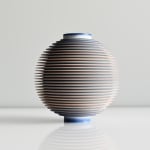





Nicholas Lees
Blue/red Orbit 23.58, 2023
17 x 16.5 x 16.5 cm
6 3/4 x 6 1/2 x 6 1/2 in
6 3/4 x 6 1/2 x 6 1/2 in
Series: orbit
Signed on base
CF1251
Photo: Nicholas Lees
Sold
Further images
These new Orbit forms are an interesting development for Nicholas Lees. Talking about this new body of work Nicholas said, 'When I first began this evolving body of lathe-turned-work, I...
These new Orbit forms are an interesting development for Nicholas
Lees. Talking about this new body of work Nicholas said, "When I first
began this evolving body of lathe-turned-work, I was a little wary of
the form being too readily that of pottery/vessel, as I wanted to give
primacy to the visual and sculptural qualities, and so I favoured more
geometric and perhaps abstract forms. I have since become more and more
comfortable with, and have realised the huge wealth of meaning and
resonance available from, engaging more directly with the vessel form.
At earlier stages in my career, I made work that was more
straightforwardly studio pottery, followed by sculpture which
consciously turned away from overt ceramic reference in form and
materiality, whilst still having the same rooted approach to thinking in
relation to material and process.
"The new
Orbit forms are nearer to the accepted identity of pot/vessel and all
the richer for it, I realise. Narrowing the depth of the boundary
between contained and occupied space has led me to engage more with the
internal void, and the full curve of the form gives more weight to the
role of surface in its dance with form and the possibility for it to
shimmer. I have also discovered the sensual and visual delight in making
a full and curvaceous form. It perhaps gave me a little insight into
why spherical objects such as moon jars are such an important and
resonant form in ceramics. I consciously avoid using the name moon jar
in relation to my works due to its specific cultural context, which is
not mine. I use the name 'Orbit' partly due to its being both a noun and
a verb and so implying both stasis and movement."
Lees. Talking about this new body of work Nicholas said, "When I first
began this evolving body of lathe-turned-work, I was a little wary of
the form being too readily that of pottery/vessel, as I wanted to give
primacy to the visual and sculptural qualities, and so I favoured more
geometric and perhaps abstract forms. I have since become more and more
comfortable with, and have realised the huge wealth of meaning and
resonance available from, engaging more directly with the vessel form.
At earlier stages in my career, I made work that was more
straightforwardly studio pottery, followed by sculpture which
consciously turned away from overt ceramic reference in form and
materiality, whilst still having the same rooted approach to thinking in
relation to material and process.
"The new
Orbit forms are nearer to the accepted identity of pot/vessel and all
the richer for it, I realise. Narrowing the depth of the boundary
between contained and occupied space has led me to engage more with the
internal void, and the full curve of the form gives more weight to the
role of surface in its dance with form and the possibility for it to
shimmer. I have also discovered the sensual and visual delight in making
a full and curvaceous form. It perhaps gave me a little insight into
why spherical objects such as moon jars are such an important and
resonant form in ceramics. I consciously avoid using the name moon jar
in relation to my works due to its specific cultural context, which is
not mine. I use the name 'Orbit' partly due to its being both a noun and
a verb and so implying both stasis and movement."





